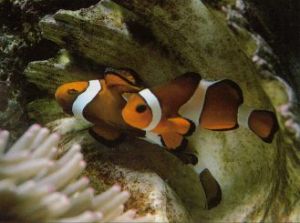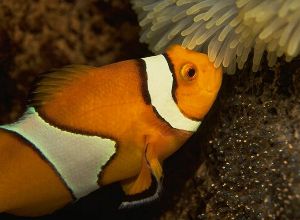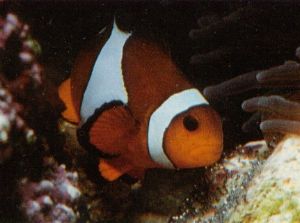 Family: Pomacentridae
Family: Pomacentridae
The spawning of clownfish nearly always takes place in the late afternoon and is a delightful scene to observe. A common precursor to this and a good indication of imminent egg laying is the ritual cleaning of the chosen spawning site. Both male and female clean the site vigorously with their mouths until they are both satisfied that the surface will be suitable. Meanwhile, the egg laying tube, or ovipositor will have become clearly visible in the female, while the male's fertilisation tube may only just be obvious.
The female will then glide over the area, depositing a neat row of sticky eggs as she goes. The male follows closely behind to fertilise the line of eggs. It is a process that will be repeated many times until a clutch of yellow/orange eggs is formed in a tight group. Commonly between 200-800 eggs may be deposited at any one spawning.
Care Of The Spawn
The male takes on the main responsibility for looking after the eggs. He will remove those eggs that are infertile and frequently mouth the viable ones. Occasionally he will vigorously waft water over the clutch in order to clear away any debris that might have lodged between the eggs and keep them well oxygenated. The female plays only a small part in caring for the eggs. She does, however, become highly territorial at this time and will expel any unwelcome visitors from the vicinity, including hands and fingers!
As the eggs develop, they become more silvery in colour and the eyes can be seen clearly after five or six days. This seems to trigger the male into becoming even more attentive and his activities become almost unceasing, even during the hours of darkness.
Initial Spawnings
It would be wise not to try and raise the larvae from the first few spawnings. Make careful observations instead and note the times when the eggs were laid and when they hatched, for this information will be vital for future attempts at raising. Parameters such as temperature, pH, specific gravity, etc., should also be recorded. Trial efforts at raising 'green' water, rotifer and brineshrimp nauplii cultures during this period will reap dividends later on. If this cannot be successfully accomplished then rearing clownfish larvae will be impossible and have to be postponed until it can.
Hatching
The larvae hatch as soon as it has been pitch dark for at least one hour. If even a small amount of light falls on the eggs, those that have not already hatched will fall inactive and emerge the next night instead.
It is impossible to rear the larvae in the same tank as the parents. Not even one individual from the most prolific of spawnings would survive. Therefore, the eggs must be removed to more suitable quarters and hatched there.
The Hatching and Rearing Tank
Some two days before the eggs are due to hatch in the main tank, set up a hatching/rearing tank. It need only be a 10 gallon, or slightly larger, aquarium furnished with a single airstone, heater/thermostat (or better still, an undertank heating mat) and a pygmy bulb for lighting. Filtration and substrate is unnecessary at this stage. Provision should be made to black out the tank completely and the temperature and pH arranged to match the main tank as closely as possible.
From the notes made on previous hatchings, it will be easy to predict the day and time of hatching with great accuracy.
On the predicted day of hatching and roughly two hours prior to lights out in the main tank, exchange half of the fresh water from the hatching tank with that of the main aquarium. Carefully remove the clutch of eggs, together with the rock on which they are attached. Exposure to air must be avoided at all costs by placing the rock in a suitably sized transference container, underwater. Introduce the eggs into the hatching tank and, if possible, position it at a steep angle against the glass wall. Place an airstone nearby to provide good water circulation but do not allow the bubbles to touch the eggs.
At this point, black out the tank totally with blankets etc., and resist the urge to look at them for at least two hours! After that time, the coverings can be removed and if calculations are correct, the tank will be filled with ravenous clownfish larvae. Any unhatched eggs, along with the rock can now be removed (unless the majority remain unhatched, in which case the procedure can be repeated on the next day).
The First Days
It will be beyond the means of the average hobbyist to raise all, or even most of the larvae and it is strongly recommended that 10-20 strong individuals be chosen to survive. This may seem extreme, but better to have a healthy fraction survive than none at all! Most of the culling will occur naturally as many will not survive the first 24 hours; these, along with the weak, deformed and thin, should be siphoned away using an airline or pipette. Do not hesitate to remove any further larvae that appear sick or weak, along with anymore that have died. In this way, it will be found that a small quantity of strong individuals remain, making the task of rearing that much easier.
Feeding
The newly hatched larvae are far too small to take brineshrimp nauplii and will require rotifers; the best species is a marine rotifer called Brachionus plicatilis. Starter cultures of this rotifer and its food source, a single-celled marine algae of the species Isochrysis galbana or Pavlova lutheri, can be obtained from specialist suppliers, some of which are listed at the end of this article. These cultures will need to be multiplied long in advance to obtain the quantities required and can prove more problematic than raising the larvae themselves!
Once the larvae have hatched, they will feed almost immediately and a quantity of rotifers can be introduced into the tank. The larvae will not swim far for a meal and consequently there must be rotifers in every part of the tank without the risk of pollution.
Feeding will be required every 2-3 hours over the first four days as a general rule. This includes the nightime hours and the reason why a pygmy bulb should illuminate the tank. These unsociable feeding hours may seem unnecessary but they produce the strongest and most highly coloured fish. Pale, weak specimens seen on sale are usually the product of poor feeding regimes with low quality cultures at the larval/fry stage.
After four days of feeding on rotifers exclusively, the fry will be large enough to take brineshrimp nauplii as well. As they grow so rapidly, baby brineshrimp should preferable be only a few hours old if the best results are to be achieved. Continue this regime for the next five days. Gradually the feedings can be reduced to one every 4-6 hours but it is essential that the fry have full and visibly distended stomachs at all times. Theory has it that if the stomach remains empty for too long, the lining fuses together causing irreparable damage. As a consequence, the fish will be unable to digest properly, even when food becomes available.
After nine days of mixed rotifer/brineshrimp, the rotifers can be phased out completely and a brineshrimp/pulverised flake food mix can be substituted.
 Growing On
Growing On
Regular water changes are vital to healthy growth and 25% of the hatching tank water must be replaced every 1-2 days (2-4 days for the growing-on tank). Needless to say, temperatures and salinity must match and the water changed fairly slowly to avoid the risk of shock.
Once the fry begin to take on adult colours at around 10 days, more spacious accommodation has to be arranged. A 20 gallon tank with an undergravel filter will be ideal. This tank must be matured long in advance of the introduction of livestock. Transfer the largest and strongest to their new home, leaving the less well developed to catch up in the rearing tank. A pre-matured sponge filter can be added to the hatching tank if it is judged that conditions require it, but certainly not before the larvae are four days old.
Continue to feed flake but add other staple marine fare to provide a varied and healthy diet.
A word of warning: never at any time net the larvae/fry. Such handling damages the fish at this delicate stage and nearly always leads to death. Use a cup, siphon or plastic bag to transfer them and only when absolutely necessary.
Disposing Of The Stock
Marine dealers can always sell good quality young clownfish at ½"+ long and will usually readily accept them. However, do not expect too much in the way of cash payment and it may be necessary to take a credit on goods to get the best deal.
Rotifers and algal cultures can be obtained from the following:
The Culture Collection of Algae and Protozoa, Scottish Marine Biological Association, Dunstaffnage Marine Research Laboratory, P.O. Box 3, Oban, Argyll, Scotland. PA34 4AD.
Resting rotifer kits, Florida Fish Farms. Can be ordered through marine retailers.
Books:
The Plankton Culture Manual by Hoff & Snell. Again, Florida Fish Farms, from Underworld Products.
Clownfishes by Joyce Wilkerson. Microcosm Ltd. Excellent book on all aspects of clownfish culture.
The Book of The Marine Aquarium by Nick Dakin. Pub. Salamander. Chapter on rearing clownfish.
Beginner to Breeder by Martin A. Moe.

